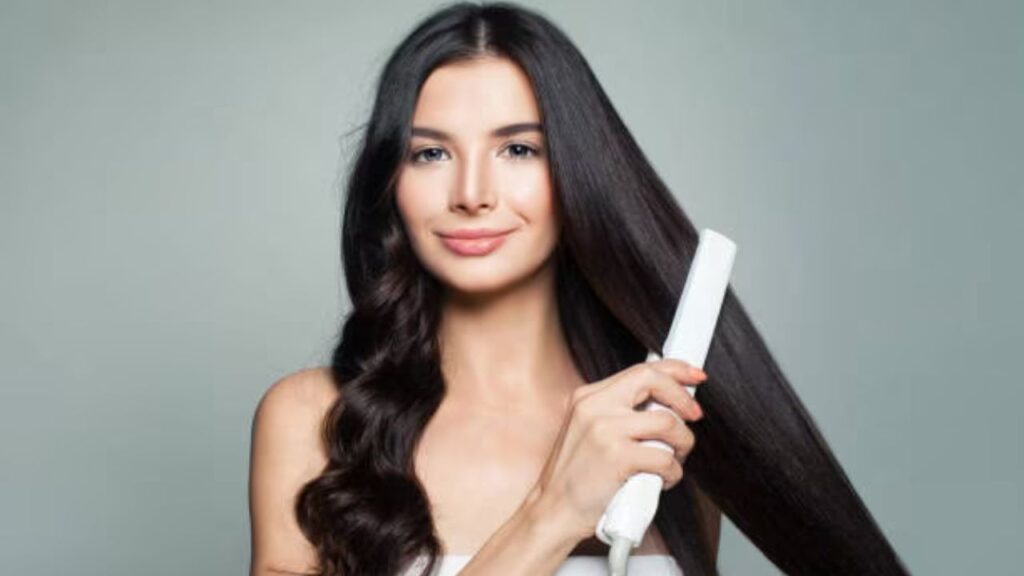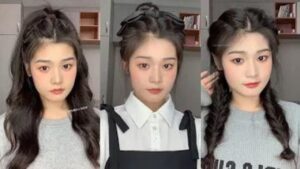
Are you dreaming of sleek, straight locks that stay perfect day in, day out? Permanent hair straightening might just be your ticket to hassle-free, stunning hair. But, before you take the plunge, let’s unravel the secrets of this popular hair styling technique. Whether it’s understanding the potential impact on your hair or addressing those burning questions, I’ve got you covered. So, let’s dive in, shall we?
The Lowdown on Hair Straightening Safety: Is It Really Safe?
Thinking about going permanently straight? The big question is: Is it safe? Well, the short answer is yes, with a little asterisk. The safety of this transformative process largely hinges on the products and techniques used. It’s all about the chemicals, darling! These powerful potions work by reconfiguring the hair’s protein structure. However, if not used correctly, they could take a toll on your luscious locks.
A Word of Caution: Mums-to-be and new mothers might want to hit pause on this treatment. It’s better to be safe, so maybe wait until after this special time to redefine your hair game.
Curious about the different ways to achieve that sleek, straight look? Stay tuned! In the next section, I’ll take you through the myriad methods of permanent hair straightening. Get ready to find your perfect hair-transforming match!
Exploring the World of Permanent Hair Straightening: Your Ultimate Guide
Ready to transform your curls and waves into silky, straight tresses? Permanent hair straightening comes in a few fabulous flavours, each with its unique charm and process. Let’s delve into the top three techniques that promise to give you that sleek, straight look you’ve been longing for.
Hair Rebonding: The Ultimate Transformation
Think of hair rebonding as a magic wand for your hair! This method restructures your hair’s natural bonds, giving you a dramatically straight look. Expect to spend a good chunk of your day at the salon, as it can take 3-8 hours, depending on your hair’s length and volume.
Procedure Breakdown:
- Your hair adventure starts with a shampoo, followed by dividing your hair into neat sections.
- A layer of relaxant is then meticulously applied, and your hair is gently secured with a thin plastic board.
- The relaxant works its magic for about 30-45 minutes, reshaping your hair’s bonds.
- A steam treatment for 10-40 minutes helps the hair absorb all the goodness.
- After rinsing out the relaxant, a deep conditioning treatment steps in to replenish moisture.
- A generous application of keratin lotion follows, ensuring your hair drinks up all the nutrients.
- Post a cold water wash, your hair is blow-dried and styled with a flat iron to reveal your stunningly straight hair!
Japanese Thermal Reconditioning: Sleek and Chic
This method is all about using heat and chemicals in harmony to alter your hair’s texture. It’s particularly popular for its long-lasting results and smooth finish.
Procedure Insights:
- Your hair journey begins with a wash and sectioning.
- A special chemical solution is applied, sitting on your hair for about 30-45 minutes, to alter the protein structure.
- Post-rinse and shampoo, your hair is straightened using heat.
- A second chemical is applied to set your hair’s new sleek form.
- Remember, you’ll need a repeat visit after three days to ensure the bonds are locked in for good.
Brazilian/Keratin Treatment: The Gentle Path to Straight Hair
Favoured for its gentle approach, the Brazilian or Keratin treatment not only straightens but also shields your hair from sun damage.
Step-by-Step Guide:
- Starting with a shampoo, your hair is then divided for easy application.
- The keratin solution is carefully applied, sitting on your hair for a short duration.
- A flat iron is then used to seal in the straight structure, leaving your hair smooth and luscious.
Considering the commitment and time involved, a professional salon is the go-to place for these transformations. However, if you’re feeling adventurous and skilled, certain aspects of these treatments can be attempted at home. But remember, for the best and safest results, trust the pros!
Achieving Straight Hair at Home: A Step-by-Step Guide
Embarking on the journey to straighten your hair at home can be both exciting and daunting. Here’s a comprehensive guide to help you achieve those straight locks safely and effectively.
What You’ll Need:
- Oil or petroleum jelly
- Hair relaxer
- Gloves
- Plastic rat-tail comb
- Hair clips
Directions:
Preparation is Key: Start by dividing your hair into four manageable sections using the rat-tail comb. Opt for a plastic comb, as metal can scratch your scalp and cause irritation when it interacts with the relaxer.
Sectioning Further: Choose one of the larger sections and divide it further into smaller subsections (about 4-6), depending on the thickness of your hair.
Protect Your Skin: With gloves on, apply oil or petroleum jelly around your hairline and roots. This step is crucial to prevent any relaxer from irritating your skin or eyes.
Application: Using either your gloved hands or the comb, apply the relaxer to the first subsection, ensuring thorough saturation and even coating. It’s important that each strand is straight and fully covered – any missed spots or bumps can lead to uneven straightening.
Repeat: Continue the same process with the remaining sections of your hair.
Timing is Everything: Leave the relaxer in your hair for the duration recommended on the product packaging – not following these instructions can lead to hair damage.
Rinsing Out: Gently wash out the relaxer with lukewarm water, and follow up with a sulfate-free shampoo and conditioner. This helps normalize your hair’s pH levels and adds moisture.
Additional Tips for Smooth Straightening:
Professional Advice: Before you begin, consult with a hair care professional, especially if your hair is fragile or prone to damage.
Post-Treatment Care: Avoid shampooing your hair for at least a week after straightening to allow your scalp to recover and prevent irritation.
Tackle Tangles: If your hair is prone to knots, ensure it’s detangled before applying the straightening solution for even coverage.
Neutralise Post-Treatment: To counteract any potential residual burning from the relaxer, use a neutralising shampoo, which also helps prevent overprocessing.
Moisturise Religiously: Since straightening can dry out your hair, incorporate a regular conditioning routine. A deep conditioning treatment once a week is highly recommended to maintain hair health.
By following these steps and tips, you can achieve beautifully straight hair at home. However, always prioritise the health of your hair and scalp and don’t hesitate to seek professional advice if unsure.
Navigating Concerns Around Permanent Hair Straightening
Permanent hair straightening can transform your look, but it’s vital to understand its implications thoroughly. Let’s address some common concerns to help you make an informed decision.
Managing Regrowth Post-Straightening
Is regrowth a challenge post-straightening? Not necessarily. Proper hair care, including regular deep conditioning, can keep regrowth manageable and healthy. However, it’s important to remember that overprocessing during straightening can lead to damaged follicles, resulting in regrowth that is weak, thin, and lacklustre.
Remember, permanently straightened hair requires ongoing maintenance. As your hair grows, retouching the new growth is essential to maintain a sleek, uniform look.
Longevity of Permanent Straightening
How long does the straightened effect last? Typically, you can expect the results to last between 4 to 6 months. However, this varies depending on individual hair growth patterns. Regular touch-ups will be needed as your roots start to show their natural texture.
Weighing the Pros and Cons
Deciding to permanently straighten your hair involves considering both its benefits and drawbacks.
Pros:
- Cost-effective when done at home.
- Eases daily hair management.
- Home kits are typically less potent than salon treatments, potentially reducing risk.
- Lasts a good 4 to 6 months.
Cons:
- Risk of hair damage, including split ends and breakage.
- Restrictions on hair colouring post-treatment.
- Results may vary; hair may not become completely straight.
- Regular maintenance is required.
- Alternative No-Heat Straightening Methods
Prefer to avoid heat? Here are some gentle techniques:
Straightening Products: Utilise a smoothening shampoo, followed by a straightening mask and conditioner.
Wet Hair Bun: Tie damp hair in a bun and let it dry naturally.
Cold Air Blow-Dry: Use the cool setting on your hairdryer while brushing your hair straight.
Large Hair Rollers: Set damp hair in large rollers overnight for smooth results.
Hair Wraps: Secure wet hair around your head with wraps to straighten it as it dries.
Straightening Comb: Comb your hair while it’s drying for a straighter appearance.
Straightening Balms: Apply these products to wet hair and style as you prefer.
Caution and Care for Straightened Hair
If you opt for chemical straightening, professional consultation is key, especially for weak or brittle hair. Post-treatment, hair becomes more susceptible to dryness, so conditioning after every shampoo is crucial. While home straightening is an option, incorrect application can lead to hair loss and breakage. Always prioritise your hair’s health and maintenance to enjoy beautifully straight tresses with minimal risk.
Frequently Asked Questions
- Is it advisable to apply oil after permanently straightening your hair?
Post-permanent straightening, it’s best to steer clear of oiling your hair for at least the initial week. This allows the chemicals to fully settle and work their magic. After this period, regular oiling is not just safe but recommended to maintain moisture and nourishment in your newly straightened locks.
- Can rice water help in straightening hair?
Rice water has been lauded for its hair health benefits, primarily due to its ability to reduce surface tension and boost hair elasticity. While it can make your hair more manageable and give a semblance of straightness, it doesn’t possess the ability to permanently straighten hair. Think of it more as a natural conditioner rather than a straightening agent.
- Does coconut milk contribute to hair straightening?
Coconut milk is a natural remedy touted for imparting a softer, more manageable texture to your hair. While it can assist in taming frizz and may give a temporarily straighter appearance, it’s not a solution for permanently straightening your hair. It’s more about enhancing the natural texture rather than altering it.
- What’s the best way to sleep with straightened hair?
To preserve the sleekness of your straightened hair during sleep, opt for satin or silk pillowcases or headscarves. These materials are known for their smooth surfaces, which significantly reduce friction and thus help prevent your hair from becoming frizzy or reverting to its natural state overnight. It’s a simple yet effective way to maintain that straight, sleek look for longer.






